
The Battle of Leipzig, also known as the Battle of the Nations, was fought from 16 to 19 October 1813 at Leipzig, Saxony. The Coalition armies of Austria, Prussia, Sweden, and Russia, led by Tsar Alexander I and Karl von Schwarzenberg, decisively defeated the Grande Armée of French Emperor Napoleon Bonaparte. Napoleon's army also contained Polish and Italian troops, as well as Germans from the Confederation of the Rhine. The battle was the culmination of the German Campaign of 1813 and involved 560,000 soldiers, 2,200 artillery pieces, the expenditure of 400,000 rounds of artillery ammunition, and 133,000 casualties, making it the largest battle of the Napoleonic Wars, and the largest battle in Europe prior to World War I.

The Hälsinge Regiment, designations I 14, I 14/Fo 49 and I 14/Fo 21, was a Swedish Army infantry regiment that traced its origins back to the 16th century. It was disbanded in 1997. The regiment's soldiers were originally recruited from the provinces of Hälsingland and Gästrikland, and it was later garrisoned in Gästrikland.

The Västerbotten Regiment, designations I 19, I XIX, I 20 and I 20/Fo 61, was a Swedish Army infantry regiment that traced its origins back to the 16th century. The regiment's soldiers were originally recruited from the province of Västerbotten, where it was later garrisoned. The unit was disbanded as a result of the disarmament policies set forward in the Defence Act of 2000.

The Västmanland Regiment, designations I 18 and Fo 48, was a Swedish Army infantry regiment that traced its origins back to the 16th century. It was disbanded for the first time in 1927 but later reraised and disbanded again in 1997. The regiment's soldiers were originally recruited from the province of Västmanland, and it was later garrisoned there.
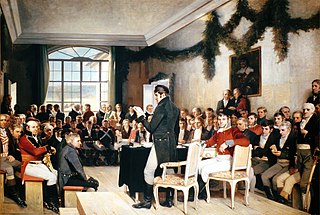
The Swedish–Norwegian War, also known as the Campaign against Norway, War with Sweden 1814, or the Norwegian War of Independence, was a war fought between Sweden and Norway in the summer of 1814. According to the Treaty of Kiel, Norway would enter a union with Sweden under Charles XIII of Sweden. The war resulted in Norway being forced into the United Kingdoms of Sweden and Norway, but with its own constitution and parliament. The war marked the last time Sweden participated in an armed conflict with another nation, and its conclusion signalled the beginning of the country's long period of military neutrality.
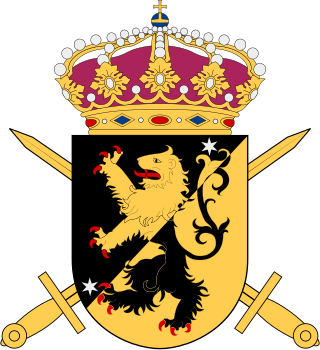
The Skaraborg Regiment, designation I 9, was a Swedish Army infantry regiment that traced its origins back to the 16th century. It was converted to an armoured regiment in 1942. The regiment's soldiers were recruited from Skaraborg County, and it was later garrisoned there.
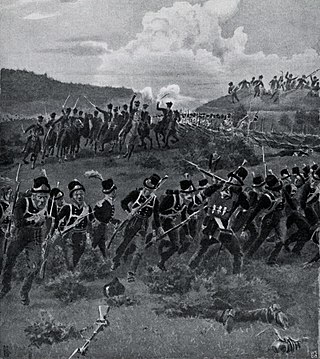
The Battle of Lier was fought on 2 August 1814 between Sweden and the newly independent Norway as part of the Swedish-Norwegian War of 1814. The battle was the first major action of the war, in which an outnumbered Swedish force attempted to storm the Norwegian entrenchment; the Norwegian victory served as an important part to boost morale among the Norwegian troops. This was the second time during the Napoleonic Wars that a battle had taken place at Lier, the first was in 1808.
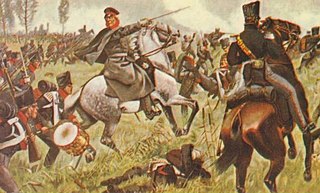
The Battle of Wartenburg took place on 3 October 1813 between the French IV Corps commanded by General Henri Gatien Bertrand and the Allied Army of Silesia, principally the I Corps of General Ludwig von Yorck. The battle allowed the Army of Silesia to cross the Elbe, ultimately leading to the Battle of Leipzig.

The Skaraborg Regiment, designation P 4, is a Swedish Army armoured regiment that traces its origins back to the 16th century. It was converted from an infantry regiment in 1942. The regiment's soldiers were originally recruited from Skaraborg County, and it is currently garrisoned in Skövde, in the former Skaraborg County.

The Kalmar Regiment, designations I 20, I 21 and Fo 18, was a Swedish Army infantry regiment that traced its origins back to the 16th century. It was merged with another unit to form a new regiment in 1928. It was later reraised and disbanded again in 1997. The regiment's soldiers were originally recruited from Kalmar County, and it was later garrisoned there.
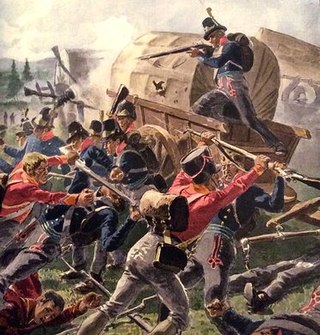
The Battle of Matrand was a military battle on 5 August 1814 between Norwegian and Swedish forces as part of the Swedish-Norwegian War of 1814. The battle took place near the village of Matrand in Eidskog and at Skotterud. It was the bloodiest battle of the entire war, in which the Swedes lost more than 340 men, of which 270 were captured; the Norwegians lost around 50 men with 90 wounded and 36 captured.

The Älvsborg Regiment, designation I 15 and I 15/Fo 34, was a Swedish Army infantry regiment that traces its origins back 1624. It was disbanded in 1998. The regiment's soldiers were originally recruited from the provinces of Västergötland, and it was later garrisoned there in the town Borås.
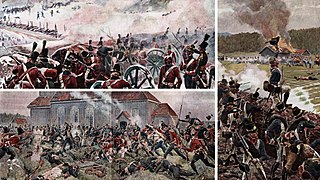
The Dano–Swedish War of 1808–1809 was a war between Denmark–Norway and Sweden due to Denmark–Norway's alliance with France and Sweden's alliance with the United Kingdom during the Napoleonic Wars. Neither Sweden nor Denmark-Norway had wanted war to begin with but once pushed into it through their respective alliances, Sweden made a bid to acquire Norway by way of invasion while Denmark-Norway made ill-fated attempts to reconquer territories lost to Sweden in the 17th century. Peace was concluded on grounds of status quo ante bellum on 10 December 1809.

The Battle of Langnes, or the Battle of Langnes Entrenchment, was a battle fought between Norway and Sweden as a part of the Swedish-Norwegian War of 1814. The battle, even as it ended inconclusively, served as a tactical victory to the Norwegians since they now could avoid an unconditional surrender to the Swedish.

Fredrikstad Fortress, under the command of Nils Christian Frederik Hals, was captured by the Swedish armed forces on 4 August 1814. 207 men remained in the fortress as the Norwegian surrendered to the Swedes; the rest had evacuated earlier. The Swedish casualties were few, 7 men killed and 12 wounded from the army, navy and Archipelago fleet combined.
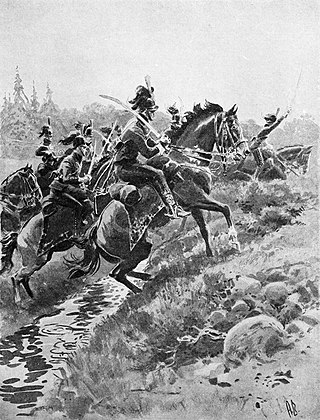
The Battle of Rakkestad was fought in the Swedish–Norwegian War of 1814, at the village of Rakkestad, Norway, between 2,000–3,000 Swedes force under Eberhard von Vegesack, and a slightly smaller Norwegian force, led by Frederik Wilhelm Stabell. The Swedish forces drove the Norwegians back from their fortified positions with a disciplined bayonet-attack and dealt them considerable losses. This battle crippled the morale of the Norwegian defenders, and especially their leader, King Christian Frederik, which contributed to a rapid end of the war, eight days later, with the Convention of Moss.

The Battle of Tistedalen was a series of skirmishes in the Swedish–Norwegian War of 1814, at Tistedalen, Norway.
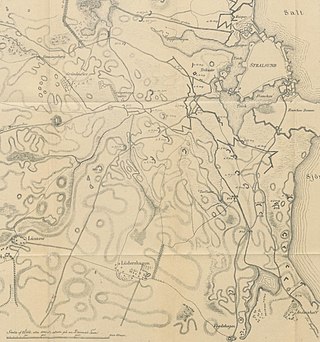
The Great Sortie of Stralsund was fought in the Franco-Swedish War on 1–3 April 1807, in Swedish Pomerania. A French army under Édouard Mortier invaded Swedish Pomerania in early 1807 and initiated a blockade of the Swedish town of Stralsund, to secure the French rear from enemy attacks. After several smaller sorties and skirmishes around Stralsund, Mortier marched part of his army to support the ongoing Siege of Kolberg, leaving only a smaller force under Charles Louis Dieudonné Grandjean to keep the Swedes at check. The Swedish commander Hans Henric von Essen then commenced a great sortie to push the remaining French forces out of Swedish Pomerania. The French fought bravely on 1 April at Lüssow, Lüdershagen and Voigdehagen, but were eventually forced to withdraw; the Swedes captured Greifswald the next day, after a brief confrontation. The last day of fighting occurred at Demmin and Anklam, where the Swedes took many French prisoners of war, resulting in the complete French withdrawal out of Swedish Pomerania—while the Swedes continued their offensive into Prussia. After two weeks Mortier returned and pushed the Swedish forces back into Swedish Pomerania. After an armistice the French forces once again invaded, on 13 July, and laid siege to Stralsund, which they captured on 20 August; all of Swedish Pomerania was captured by 7 September, but the war between Sweden and France continued until January 6, 1810, when the Swedes were finally forced to sign the Treaty of Paris.
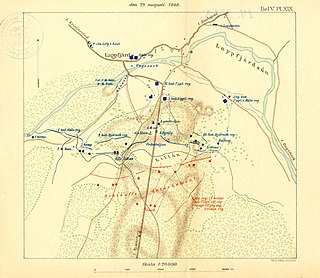
The Battle of Lappfjärd was fought between Swedish and Russian forces at Lappfjärd in Finland on 29 August 1808 during the Finnish War.

The Battle of Skellefteå took place during the Finnish War, on 15 May 1809, when 6,000 Russians under Pavel Andreyevich Shuvalov attacked 700 Swedes under Johan Henrik Furumark, at Skellefteå, Sweden. The Swedes, who fought a delaying action to buy time for their provisions to be escorted to safety, were captured as the Russians flanked around and cut-off their way of retreat. Most provisions, however, were saved.






















